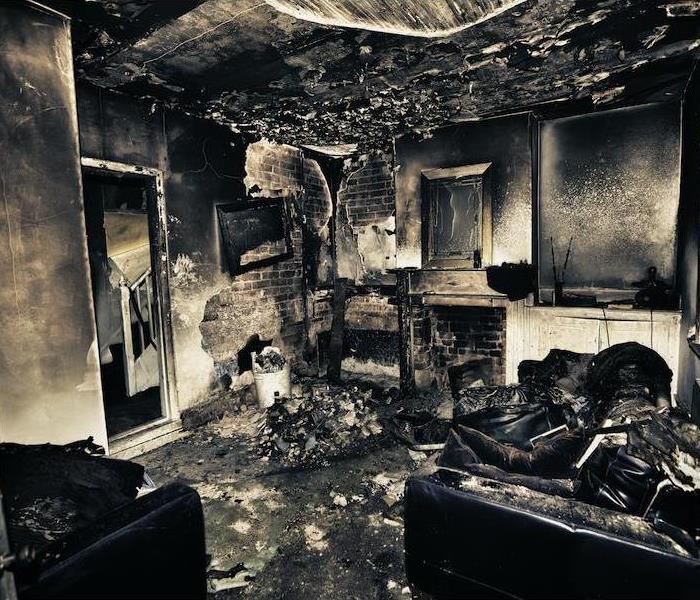What Makes Smoke Residues a Threat in Monroe Homes After Fire Damage?
9/23/2021 (Permalink)
 We have the training, expertise, and state-of-the-art equipment to restore your home to pre-damage condition after a fire. Call us right away.
We have the training, expertise, and state-of-the-art equipment to restore your home to pre-damage condition after a fire. Call us right away.
With Many Surfaces and Contents Affected by Migrating Smoke Residue and Soiling, Our SERVPRO Professionals Can Help With Cleaning and Restoring These Areas.
Smoke can become one of the most problematic obstacles for our responding technicians to overcome in Monroe homes after a fire loss. Understanding the sciences behind the creation and dispersal smoke damage throughout the property can help you appreciate your need for professional restoration as soon as extinguishment is completed. Because We’re Faster To Any Size Disaster, many residents have looked to our experience and quick arrival to limit the spread and severity of fire loss effects.
As challenging as fire damage in Monroe homes and businesses can become, each of these situations must be approached carefully to recover damaged contents, structural elements, and other valuables. Smoke damage can leave residues on surfaces and contents, which can vary in consistency and thickness to impact how easily our technicians can remove these coatings. After a careful inspection in the initial phases of job scoping by our project manager, we can best determine the ideal approaches to remove smoke residues on multiple services.
When Is Smoke Damage Created?
The decomposition of burning materials creates smoke. Specific structural elements and items can cause a higher volume or spread of this smoke production. These different materials also determine the composition of the smoke itself. For example, burning organic compounds can release carbon monoxide and hydrogen cyanide, which can be damaging to occupants of the house or even our responding technicians without the appropriate personal protective equipment. Smoke typically consists of a collection of:
- Solid Particles
- Aerosols
- Gases
- Suspended Particulates
What Characteristics Exist in Smoke Damages?
There are reasons that there are multiple ways of removing smoke damage from a house after a fire. There are varying characteristics from the production of smoke that must get addressed individually to ensure that the full threat has gotten resolved. Understanding the variances in composition or smoke damage can be beneficial for the necessary tasks to eradicate this threat. To help you appreciate which methods work the best for removing smoke damage and residues, it is important to 1st understand the significantly challenging characteristics of smoke. These include:
Gases: Gas is the invisible element of smoke damage, but also can be one of the most physically compromising to those exposed. Gaseous byproducts generated during combustion can immediately threaten those attempting to vacate the house before extinguishment takes place.
Smoke particles: Particles of smoke are microscopic and usually consist of carbon. The presence of these particles makes smoke damage visible to the occupants of the house and our responding technicians. Each of these particles can vary in size between .1 to 4 microns in size. Its substantially small size can make it threatening to the human respiratory system if inhaled.
Aerosols: Aerosols are another threat that exists in spreading smoke conditions after a fire. Much like solid particles circulating in the smoke, aerosols get generated from the presence of liquid and extremely fine solid matter suspended in the gas.
What Are Different Types of Smoke Residues?
Many homeowners do not realize that residues from smoke can vary from one house and fire to another. Depending on numerous factors, including the heat of the blaze and the materials affected, various residues can provide challenges for our SERVPRO technicians. Understanding the types of smoke residues can ensure that our technicians choose the right method of removal and restoration for the affected materials and surfaces of your property. The primary examples of smoke residues include:
- Dry Smoke
- Wet Smoke
- Protein Smoke
- Fuel Oil Smoke
What Methods Are Best for Removing Smoke Effects?
Depending on the type of smoke damage that exists, there are multiple tactics to remove residues and particles from surfaces and contents in the house. In most situations, wipe cleaning, in multiplication, and soda blasting are among the top choices for surface recovery when the underlying material has not become too compromised to protect. Our technicians must be careful to prevent any staining or smearing of wet spoke residues and other coatings to avoid unnecessary tear-out and reconstruction whenever possible.
Fire losses can be a widespread threat that impacts more than the immediate area around the combustion site. With experienced technicians and adequate equipment, our SERVPRO of Monroe / West Monroe team can help whenever you call (318) 345-5121.






 24/7 Emergency Service
24/7 Emergency Service